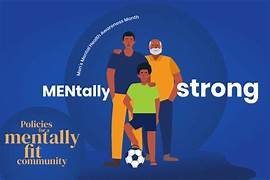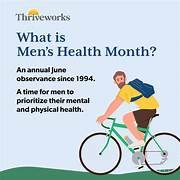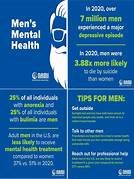Men's Mental Health Month: Breaking Stigmas and Building Support"

More than just a date on the calendar, Men's Mental Health Month is an important chance to raise awareness, dispel stigmas, and provide support to men who are struggling with mental health issues. Many men continue to suffer in silence despite advancements in mental health awareness, hindered by cultural norms that discourage showing weakness and asking for assistance. The figures are concerning: although men commit the majority of suicides globally, they are much less likely than women to seek mental health therapy. This discrepancy emphasizes how critical it is to remove the obstacles keeping men from getting the assistance they are entitled to. The current status of men's mental health is examined in this blog, along with the cultural forces that fuel stigma and practical measures that we can all take to foster an environment where men feel encouraged to put their mental health first. Let's start implementing significant change this month.
When is Men’s Mental Health Awareness Month?

What is the blog’s objective? Are you spreading knowledge, talking about your own experiences, or offering helpful guidance?
Who is the intended audience? Are you speaking to a general audience interested in mental health, males, or their families?
Your blog’s tone, style, and material will be determined by your well-defined objective.
To make your blog stronger, use reliable sources:
Provide data to demonstrate how serious the problem is.
Make use of knowledgeable statements from researchers or psychologists.
For additional reading, consult mental health groups.
For instance:
Make use of an interesting tone: Make it sympathetic and conversational.
Construct distinct headlines and subheadings: “Why Men’s Mental Health Deserves More Attention” is one example.
“Practical Ways to Take Care of Your Mental Health”
Add images: To interest readers and break up text, use infographics, charts, or pictures.

Use hashtags like #MensMentalHealthMonth or #BreakTheStigma when posting the blog on social media.
Post it in mental health-related forums or communities, such the mental health community on Reddit.
Work together with organizations or influencers to spread the word.
For instance:
Tweet: “Let’s encourage the men in our life and fight the stigma this Men’s Mental Health Month. To find out how we can change things, read my blog! [Link] #MensMentalHealth #MentalHealthAwareness “Should we concentrate on obtaining materials and images initially, or would you want to begin writing a certain portion first?
Provide data to demonstrate how serious the problem is.
Make use of knowledgeable statements from researchers or psychologists.
For additional reading, consult mental health groups.
For instance:
Figure: “More than 6 million men in the U.S. experience depression annually.”
Translation: “Asking for help is not a sign of weakness but a step toward strength.” — Clinical psychologist Dr. John Doe.
Start writing the blog post using your outline as a guide. Here are some pointers:
Make use of an interesting tone: Make it sympathetic and conversational.
Construct distinct headlines and subheadings: “Why Men’s Mental Health Deserves More Attention” is one example.
“Practical Ways to Take Care of Your Mental Health”
Add images: To interest readers and break up text, use infographics, charts, or pictures.
During Men’s Mental Health Month, efforts are made to raise awareness of the stigma associated with mental health concerns and to dispel it. Because men are usually expected to be tough, stoic, and independent, they may repress their feelings and leave mental health issues untreated. Despite being responsible for the majority of suicides globally, statistics indicate that men are much less likely than women to seek mental health therapy.
This month promotes candid discussions on mental health and emphasizes the value of self-care, emotional openness, and asking for assistance when necessary. It’s a chance to dispel damaging misconceptions and establish a culture that encourages guys to put their mental health first. By promoting empathy, exchanging resources, and raising awareness,


Men’s Mental Health Month serves as a crucial reminder of the often-overlooked mental health issues. Men have been trained by society to suppress their emotions, endure discomfort, and refrain from getting treatment for psychological or emotional problems for far too long. Phrases like “man up” and “be a man” have perpetuated the notion that showing weakness is a sign of vulnerability, which has caused many men to suffer in silence. The repercussions are severe: three out of four suicides in the United States are committed by men, making them much more likely to die by suicide.
This month is a call to action, asking society and men alike to reconsider these detrimental conventions and adopt more positive perspectives on mental health.
In addition to raising awareness, Men’s Mental Health Month aims to create a culture in which men are at ease talking about their difficulties, asking for support, and encouraging one another on their paths to mental health. The narrative needs to be changed so that no male must deal with his mental health issues alone. We can establish a supportive environment where each man feels empowered to take care of his mental health by starting the conversation, offering resources, and setting an example.
Addressing the particular difficulties men encounter with relation to their mental health is made possible by Men's Mental Health Month. Social conventions have long perpetuated the idea that males should be tough, emotionally strong, and independent, which frequently causes them to repress their feelings. This "silent struggle" might keep men from getting the help they sorely need and can cause emotions of loneliness, despair, and anxiety. The harsh truth is that men are frequently less inclined than women to seek mental health treatment. Social norms have long taught males to bear the effects of depression, anxiety, and PTSD alone, even though they are equally, if not more, likely to develop these conditions.
